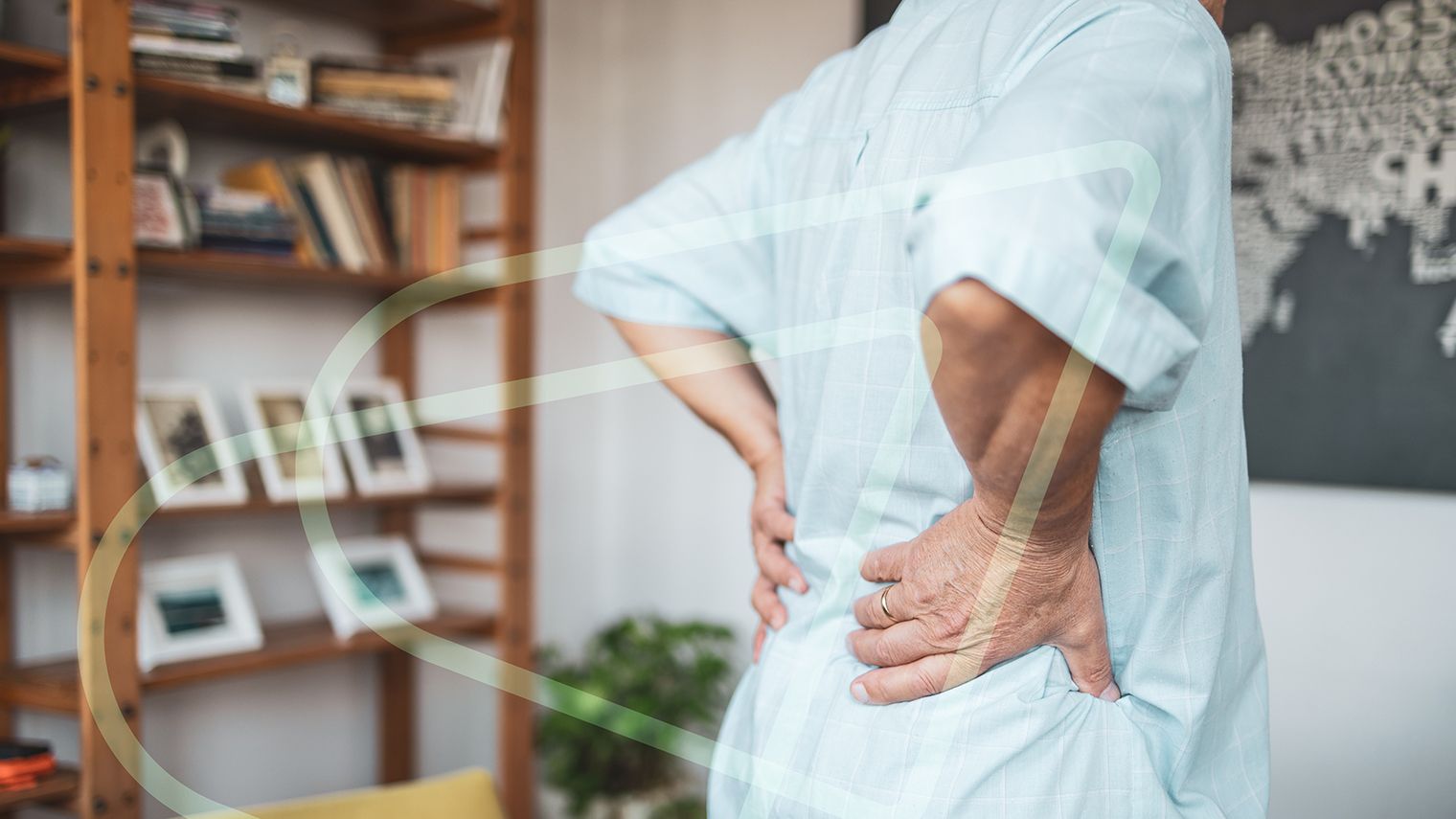Why Ulcerative Colitis (UC) Causes Back Pain and What You Can Do About It
February 14, 2024
Content created for the Bezzy community and sponsored by our partners. Learn More

Photography by MStudioImages/Getty Images
UC causes many symptoms outside of the gut. Back pain is one of them, but it can be managed with medication, physical therapy, and lifestyle changes.
You’re already familiar with the havoc ulcerative colitis (UC) can wreak on your digestive system. Hopefully, you and your doctors have come up with ways to manage your symptoms daily.
However, UC can actually affect the body beyond the large intestine. If you’ve been experiencing back pain, you’re not alone: It’s an often-overlooked (but common!) complication of UC.
Ulcerative colitis back pain is more than just an annoying side effect of the condition: It can significantly alter your quality of life. After all, you’d probably prefer to be out exploring the world and making the most out of life — not lying immobile on the sofa.
So, if you’re experiencing UC back pain, read on for info on why ulcerative colitis causes back pain, the nature of that pain, and the treatment options.


What kind of back pain do people with UC experience?
If you’re living with ulcerative colitis, you may experience a specific type of back pain known as sacroiliitis. More than 16% of people living with UC have sacroiliitis. This condition involves inflammation of the sacroiliac joints, where the lower spine and pelvis connect.
Sacroiliitis can cause discomfort or pain in your buttocks and lower back, and the pain can extend down your legs. The pain typically worsens with prolonged standing or stair climbing and may be relieved somewhat by lying down.
Sacroiliitis is a feature of a type of arthritis called axial spondyloarthritis. This disorder, along with its more intense variant, ankylosing spondylitis (which affects 3% of people with UC), leads to inflammation in the spine — and both of these conditions can create back pain.
Why do people with UC experience back pain?
You probably already know that UC is an inflammatory disease. But did you know that the chronic inflammation in your digestive tract can trigger an immune response affecting other parts of the body? For many people living with ulcerative colitis, that includes the sacroiliac joints.
Sacroiliitis is inflammation of the sacroiliac joint. The sacroiliac (SI) joint is one of the largest joints in the body. It connects the triangular bone — the iliac bone — at the base of your spine to the largest part of your hip bone. And when your SI joint is inflamed, you’ll likely feel discomfort and pain in your lower back.
How is sacroiliitis diagnosed?
If you’re living with UC and experiencing persistent back pain, get in touch with your doctor or healthcare professional. The diagnostic process typically involves a physical exam to assess pain and mobility. You may also need X-rays, an MRI, or CT scans to detect changes in your SI joints.
The symptoms of sacroiliitis are similar to those of sciatica, but the pattern of the pain will help your doctor distinguish which condition is causing your trouble. While both begin in the lower back, sciatica will always follow the path of the sciatic nerve and may extend beyond the knee, while sacroiliitis won’t follow any strict nerve pathway.
Your doctor might also conduct some blood tests to rule out other conditions and to check for markers of inflammation. They may also try some anesthetic or steroid injections to test whether this relieves the symptoms.
What treatments can help relieve back pain with UC?
Ulcerative colitis back pain is treated similarly to other types of back pain. Treatments for UC back pain relief may include:
- Medication: Anti-inflammatory drugs or TNF inhibitors can reduce joint inflammation and pain. Certain anti-inflammatories may be off-limits for people living with IBD, however, so be sure to talk with your doctor about the best specific drugs and treatment plan before you start reaching for the ibuprofen.
- Physical therapy: Tailored exercises can improve joint function and reduce discomfort.
- Steroid injections: Image-guided injections of anesthetics or steroids can have a therapeutic effect for people living with ulcerative colitis back pain, too.
- Joint fusion surgery: In extreme cases, surgical intervention may be a last-resort option.
Your healthcare team will help you figure out the most effective treatment plan for your symptoms and needs.
FAQs
Is back pain a common symptom of ulcerative colitis?
Back pain is not the most common symptom of ulcerative colitis, as UC primarily affects the colon and rectum. But people with UC are three times more likely to experience sacroiliitis than people without UC.
How can I tell if this is ulcerative colitis back pain, or something else?
UC-related back pain is typically inflammatory. If your back pain correlates with flare-ups of UC or you have other symptoms of inflammation (like fever, fatigue, or joint pain), it might be related to UC. Consulting with a healthcare professional is the best way to determine the cause.
Does diet affect ulcerative colitis back pain?
Though there’s no specific diet to cure UC or its associated back pain, some dietary strategies can help you manage symptoms. Foods that cause flare-ups in UC symptoms might also exacerbate associated back pain, so keeping a food diary to track and identify trigger foods can be helpful.
Can managing stress help reduce ulcerative colitis back pain?
Managing stress is beneficial for everyone, regardless of whether they’re living with UC or not. But it’s also true that stress can aggravate UC symptoms and potentially increase back pain. Techniques like deep breathing, meditation, and yoga can help manage stress. Mindfulness and cognitive behavioral therapy (CBT) are also effective in managing chronic pain associated with UC.
Is surgery ever necessary for UC back pain?
Surgery for UC-related back pain is rare and typically considered only in severe cases where conservative treatments haven’t worked. The decision to proceed with surgery would depend on many factors, including the extent of the damage and your overall quality of life.
The takeaway
Back pain, particularly sacroiliitis, is a significant complication of ulcerative colitis — but a manageable one. Understanding the symptoms and getting an early diagnosis will give you the best chance of managing pain effectively. Your healthcare team can help you find the right treatment options for your ulcerative colitis back pain so you can resume living the life you want.
Medically reviewed on February 14, 2024
7 Sources


Like the story? React, bookmark, or share below:
Have thoughts or suggestions about this article? Email us at article-feedback@bezzy.com.
About the author